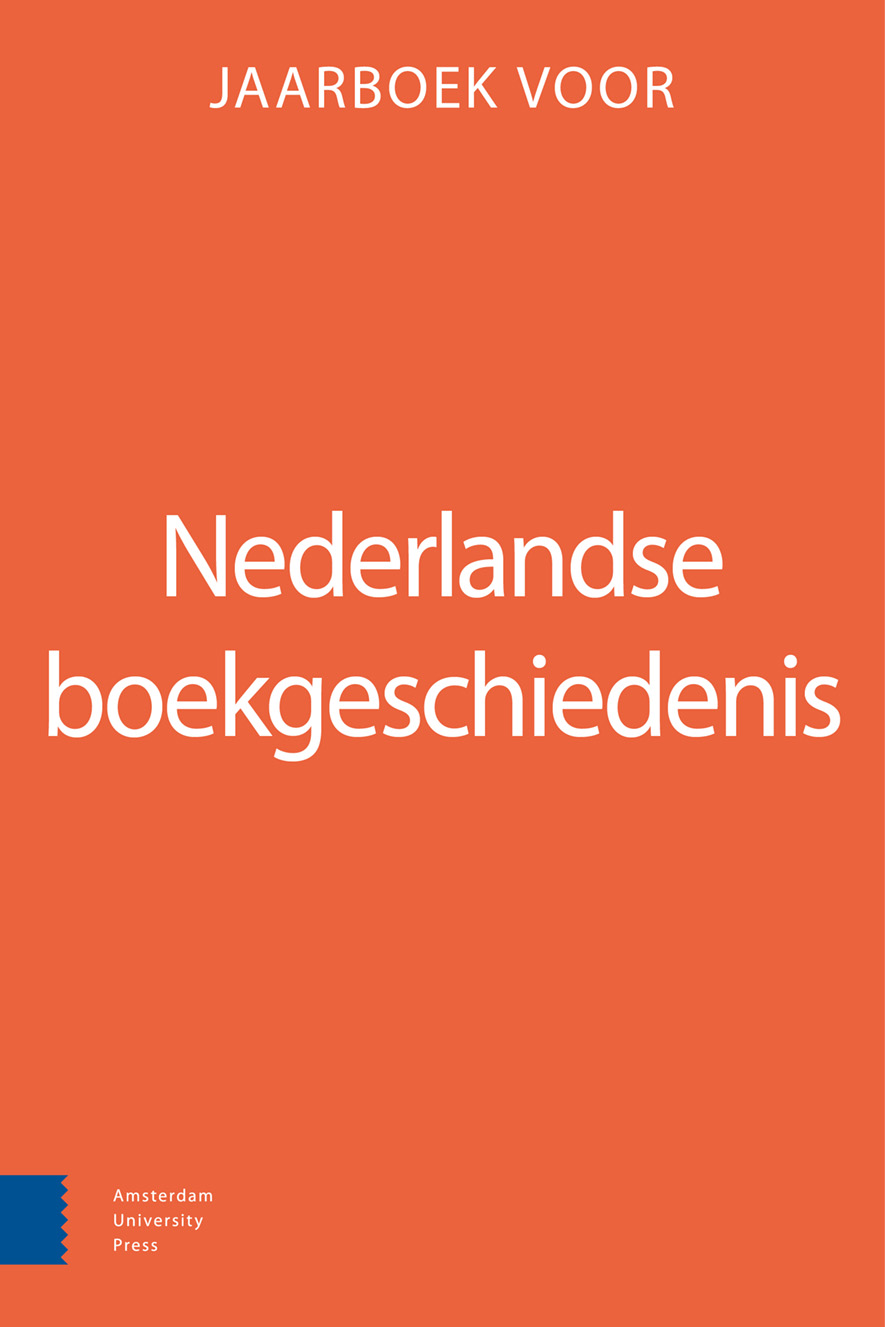Jaarboek voor Nederlandse Boekgeschiedenis - Current Issue
Volume 31, Issue 2024, 2024
- Redactioneel
-
- Artikel
-
-
-
Met een gerust hart op weg naar het einde?
More LessAbstract On 1 April 1522, Jan van Doesborch published in Antwerp his Pronosticatie for the year 1524, which appears to be largely a translation of the German compilation text Auszug etlicher Practica und Propheceyen. This prognostication, like its German counterpart, covers the years 1518 to 1524. This seems rather out of date. The two main questions that are answered in the article are why Do Read More
-
-
-
-
Oorlog, opbouw en ophef
More LessBy Arjan NobelAbstract In 1609, Philippus Nisius, minister of the Dutch village of Klaaswaal, published the pamphlet De Wapenen des Geestelijcken Leeken ofte Boeren Crijchs. Like many other pamphlets in this period, its tone was fiercely anti-Catholic. Embedded within the contents of this booklet, however, is also a broader theological discussion of the doctrine of Christ’s Descent into Hell, which led to controversy in the Dordrecht classis, coi Read More
-
-
-
Johannes Fridericus Helvetius en de Steen der Wijzen
More LessAbstract In 1667 the Dutch physician Johannes Fridericus Helvetius published the book Vitulus aureus, in which he described an unannounced visit by a mysterious alchemist at his house in The Hague. This stranger, who went by the name of Elias Artiste, claimed to possess pieces of the Philosopher’s Stone and proceeded to instruct Helvetius in how to transmute lead into gold. A short time after the publication of Vitulus Read More
-
- Article
-
-
-
Bernard Picart’s controversial visual rhetoric
More LessBy Steff NellisAbstract This paper presents a close analysis of Bernard Picart’s 1727 frontispiece for Jean-Frederic Bernard’s Cérémonies et coutumes religieuses de tous les peuples du monde (1723-1737), employing the concept of theatricality to interpret its visual and communicative significance within the early eighteenth-century religious and cultural landscape. The frontispiece serves as a gateway to the subse Read More
-
-
- Artikel
-
-
-
‘Niet weder aan malkanderen gezet’ of ‘hoe een boekverkoper zijn eigen uitgave moest versnijden’
More LessAbstract Zutphen 1752. The city council is in turmoil after receiving a letter from the protestant University at Harderwijk about the second book written by the Zutphen pastor Johannes Ernestius Jungius. Despite a former warning from the same university considering Jungius’ end time expectation statements in 1749, he tried to publish the Verklaring van de Roomschen paus voor het beest en den antichristus Read More
-
-
-
-
‘Wij hebben den Führer gezien’
More LessAbstract Between 1940 and 1945, three originally German children’s books about Adolf Hitler circulated in translation in the Netherlands at the behest of the Nazi regime: Moeder, vertel eens wat van Adolf Hitler! (Mother, tell us something about Adolf Hitler!) in 1942 by Johanna Haarer, De Führer (The Führer) in 1943 by Erich Beier-Lindhardt and Wij hebben den Führer gezien (We have seen the Führer) in 1944 by Wilhelm Di Read More
-
-
-
Kinderboeken heruitgeven
More LessAbstract In February 2023, a controversy emerged over proposed changes to Roald Dahl’s children’s books by the publisher Puffin. The modifications aimed to make the books more inclusive and sensitive to modern readers. Changes included altering character descriptions to avoid potentially offensive terms, adding contextual information to clarify statements, and using gender-neutral language in place of gender-s Read More
-
-
-
‘An diversche steden ende landen gesproten’
More LessAbstract This article offers an overview of libraries labelled publica in the Spanish Netherlands in the period 1600-1660. The bibliotheca publica began to emerge in that region at the beginning of the century, seemingly following examples elsewhere in Europe. Scholarship concerning those early ‘public libraries’ in the Habsburg Netherlands has been scant, and mostly focuses on one or two specific institutions. This research Read More
-
-
-
Literair auteurs als aanvragers van boekverkopersprivileges in de Republiek
More LessAbstract This is an exploratory study of printing privileges requested by literary authors in the Dutch Republic during the long seventeenth century. Copyright for authors in the Netherlands was only formally arranged in the nineteenth century, but authors claimed ownership over their texts before that as well. Printing privileges were one of the instruments available to authors, although these were most often requested by b Read More
-
-
-
De ‘Refuge Huguenot’
More LessAbstract This contribution focuses on the intellectual and historical question about the significance of the French book trade for the European Enlightenment, with special attention to Amsterdam. The city was an important center of book production and housed a large French-speaking community, especially after the arrival of Huguenots and other immigrants. Their presence stimulated not only the production of French Read More
-
-
-
Boekbanden in boekbanden
More LessAuthors: Astrid Beckers, Leanne Eras-De Wit & Daniël ErmensAbstract It is well known that bookbinders reused parchment leaves from discarded manuscripts to strengthen the bindings of new books. So far, little attention has been paid to the reuse of the bookbinding materials that have been reused in bookbindings. In this article we focus on these materials that have been recycled in bookbindings, e.g. boards, covers, wrappers, metal fastenings, ivory plaques. Using online databas Read More
-
Volumes & issues
Most Read This Month Most Read RSS feed
Article
content/journals/13810065
Journal
10
5
false
en


